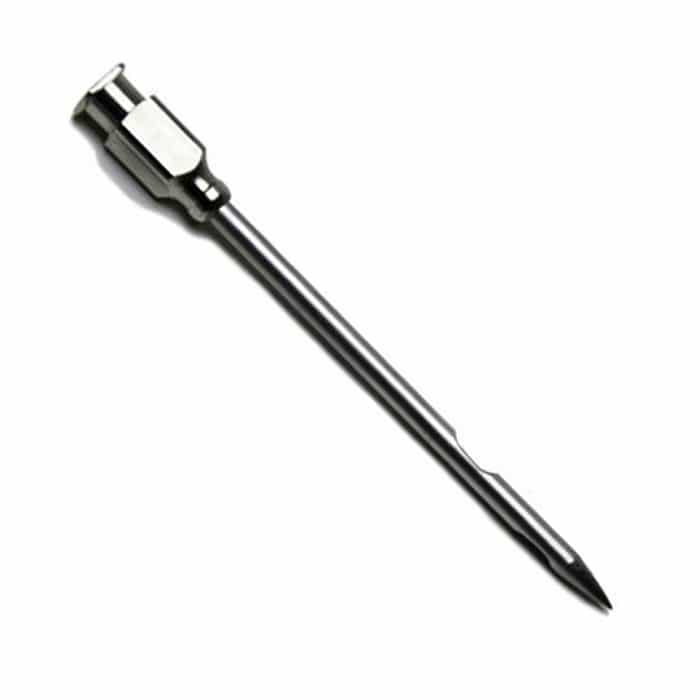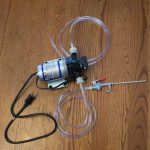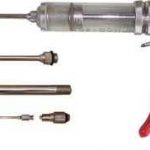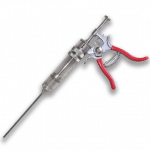Get Flavor Deep Into The Meat With An Injector
Published On: 5/23/2019 Last Modified: 6/16/2025

You don’t need a Wonderbra to enhance chicken and turkey breasts. Or, for that matter, beef brisket, pork butt. The truth is that rubs, mops, marinating, brining, and sauces can deliver a lot of flavor to the surface of meat, but if you really want to get salt or flavor deep into meat, the solution is injecting (see my articles on marinating and brining and curing). Having an injector also opens up other fun possibilities: stuffing jam into donuts, syrup into ice-cream, and melted butter into squash.
Many meat processors routinely inject meats like turkey, chicken, and pork at the factory. Injecting, or enhancing as food processors call it, is a sure fire way to get the flavor and juiciness down deep. And it is the only way to get fats, herbs, spices and other large molecules deep into meat. You don’t have to worry about oversalting, you can do it at the last minute so there’s no waiting, you have less waste, no huge containers are needed, there are no refrigerator space problems, and there are few safety issues.
The secret to injecting is to go easy. A good guideline is to shoot for 1 to 2% salt, no more than 4%. It is like brining and the salt helps retain moisture as well as enhances flavor. I skip the big flavors like garlic, pepper, and herbs that mask the natural flavor of the meat. I have judged pulled pork and brisket at barbecue competitions where the meat was gushing juice, but it didn’t taste like meat. It tasted like apple juice and garlic. I want pork that tastes like pork, beef that tastes like beef, and turkey that tastes like turkey.
The best solutions are salt water, salted butter, or stock. And you don’t need much. Muscle is 75% water and it is saturated. There isn’t much room in there for more liquid. Your injection will go in between the muscle fibers and bundles, not within the fibers, so you won’t need much. With luck you might be able to get another 10% in there. Put the meat in a pan, insert the needle every inch or two, push it to the center, and slowly push in the plunger as you slowly pull out the needle. Keep doing this until it starts to squirt out. Check out my injection recipes here.
Many competition cooks like to inject with a product called Fab B Light or Butcher BBQ Brisket Marinade, both moisturizers, tenderizers, and flavor enhancers. Fab B contains hydrolyzed soy protein, vegetable oil, sodium phosphates, monosodium glutamate, autolyzed yeast extract, xanthan gum, disodium inosinate, and guanylate. Butcher contains hydrolyzed vegetable protein (hydrolyzed soy and corn protein and salt, with partially hydrogenated vegetable oil [cottonseed, soybean] added), monosodium glutamate, sodium phosphate, and xanthan gum. Some traditionalists think this is way too Barry Bonds and are repulsed by the idea. The results speak for themselves. They are winning. A lot.
To inject, you need a gizmo, and something to put in it.
There are a number of injection gizmos on the market ranging from simple hypodermics to pumps that look like something used by the Orkin man.
For home use, a good sturdy specialty meat injector hypodermic will do. The needles for this purpose are different than normal hypodermics. They aren’t open at the tip because a large opening at the tip gets clogged easily. Meat injectors have holes in the sides of the needles, and the tip is a sharp point.
When you inject it is important that the tip go all the way through the meat until it almost pops out. If the needle isn’t long enough then go halfway through, flip it over and inject from the other side. Inject every inch or two an, this is important, as you withdraw the needle, continue to push down on the plunger so injection is dispersed from top to bottom.
A good injector has a really sharp tip, and a sturdy connection between the needle and the body of the syringe, but the needle should be easy to remove. The plunger should have a sturdy connection to the body and a good tight gasket between it and the interior of the syringe. I prefer a silicone gasket. It should be easy to break down and clean, and you should be able to store the needle inside the syringe so it is compact and you don’t lose the needle. It should have a capacity of at least two ounces and be made of stainless steel. The inexpensive plastic syringes I’ve owned eventually cracked with age or burst under pressure. Brass, copper, and aluminum are not good for this purpose, since they can react with the salt. Look for stainless steel.
Up your game: Join our Pitmaster Club. Try it out for free for 30 days. No credit card is needed. No spam. Join now and Be Amazing!
A trick
The problem everyone has with injectors is filling them. Most of us mix the injection and stick the needle into it and suck it up. But the position of the holes in the needle prevents you from getting it all, and they suck up a lot of air. This can be aggravating when you are using just a half stick of butter for a turkey breast or a small amount for a couple of turkey breasts.
The solution is to mix your injection, pour it in a glass or cup, and put a drinking straw over the needle. Stick the straw in the cup and it works perfectly!
Need State Of The Art Equipment? Get The Pork Injector
The Pork Injector is a motorized "Auto Pump Injector System" that can save you time and hand cramps if you have to inject a lot of meat.Spitjack 2-Ounce Injector Gun Is A Step Up From Basic Stainless Models
This injector is a serious tool for competition barbecue. You can order it with 1, 2, or 3 needles. It's a step up from basic models.NoCents 1 Gallon Injector Is A BBQ Competition Favorite
Many competition cooks and caterers use big pumps like this one. A single needle and a gallon jug allow you to inject lots of food fast.Chops Power Injector Systems Are Perfect For BBQ Caterers
If you are a BBQ caterer or restaurateur or a competitor, or even a weekend warrior who cooks for a crowd, you need this injector!Inject Maximum Flavor Into Your Meat With A Trio Of Brines
Chops Power Injector Systems Are Perfect For BBQ Caterers
Need State Of The Art Equipment? Get The Pork Injector
NoCents 1 Gallon Injector Is A BBQ Competition Favorite
Spitjack 2-Ounce Injector Gun Is A Step Up From Basic Stainless Models
Premiala's Clever Meat Injector Gets ALL Your Marinade Into The Meat
Related articles
- The Science of Injecting Meat: No Wait, No Waste, More Flavor
- Inject Maximum Flavor Into Your Meat With A Trio Of Brines
- Marinade Myths And How To Add Flavor More Effectively
- Salting, Brining, Curing, And Injecting (3 Recipes, 2 Pages, 6 Articles)








High quality websites are expensive to run. If you help us, we’ll pay you back bigtime with an ad-free experience and a lot of freebies!
Millions come to AmazingRibs.com every month for high quality tested recipes, tips on technique, science, mythbusting, product reviews, and inspiration. But it is expensive to run a website with more than 2,000 pages and we don’t have a big corporate partner to subsidize us.
Our most important source of sustenance is people who join our Pitmaster Club. But please don’t think of it as a donation. Members get MANY great benefits. We block all third-party ads, we give members free ebooks, magazines, interviews, webinars, more recipes, a monthly sweepstakes with prizes worth up to $2,000, discounts on products, and best of all a community of like-minded cooks free of flame wars. Click below to see all the benefits, take a free 30 day trial, and help keep this site alive.
Post comments and questions below
1) Please try the search box at the top of every page before you ask for help.
2) Try to post your question to the appropriate page.
3) Tell us everything we need to know to help such as the type of cooker and thermometer. Dial thermometers are often off by as much as 50°F so if you are not using a good digital thermometer we probably can’t help you with time and temp questions. Please read this article about thermometers.
4) If you are a member of the Pitmaster Club, your comments login is probably different.
5) Posts with links in them may not appear immediately.
Moderators